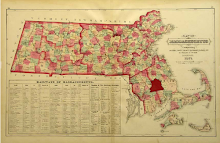 While the image of smiling children on cranberry bogs, pails in hand with the September sunshine on their faces may present an idyllic picture of local rural childhood a century ago, in truth the employment of children on local cranberry bogs was an often overlooked aspect of tthe child labor problem in America.
While the image of smiling children on cranberry bogs, pails in hand with the September sunshine on their faces may present an idyllic picture of local rural childhood a century ago, in truth the employment of children on local cranberry bogs was an often overlooked aspect of tthe child labor problem in America. In 1893 when the Plymouth Old Colony Memorial reprinted the following small news item from one of Middleborough's newspapers, few people probably showed little surprise when they read of the subject's age. "A little girl in South Middleboro five years old," ran the report, "picked 28 quarts of cranberries in one afternoon". While the item was published to bring attention to the young girl's remarkable achievement of picking so many berries in so short a period of time, the more troubling aspect of the report was the girl's age. In fact, children as young as three years old were regularly employed during the cranberry picking season in September and October, not only in Middleborough, but throughout the cranberry-growing regions of the nation.
In 1893 when the Plymouth Old Colony Memorial reprinted the following small news item from one of Middleborough's newspapers, few people probably showed little surprise when they read of the subject's age. "A little girl in South Middleboro five years old," ran the report, "picked 28 quarts of cranberries in one afternoon". While the item was published to bring attention to the young girl's remarkable achievement of picking so many berries in so short a period of time, the more troubling aspect of the report was the girl's age. In fact, children as young as three years old were regularly employed during the cranberry picking season in September and October, not only in Middleborough, but throughout the cranberry-growing regions of the nation.  Children would be engaged in all manner of tasks on the local bogs, including picking by hand and toting. Conditions on the bogs could, at times, be inhospitable. Frequently damp in the morning, the bogs were also subjected to broiling sunshine in mid-afternoon as child pickers slowly made their way on their hands and knees over the vines. Further, sanitary facilities for workers were frequently lacking. Despite these conditions, child labor on the cranberry bogs typically garnered little attention from reformers or lawmakers as children were generally employed in the company of their parents who could therefore oversee their welfare directly.
Children would be engaged in all manner of tasks on the local bogs, including picking by hand and toting. Conditions on the bogs could, at times, be inhospitable. Frequently damp in the morning, the bogs were also subjected to broiling sunshine in mid-afternoon as child pickers slowly made their way on their hands and knees over the vines. Further, sanitary facilities for workers were frequently lacking. Despite these conditions, child labor on the cranberry bogs typically garnered little attention from reformers or lawmakers as children were generally employed in the company of their parents who could therefore oversee their welfare directly. In 1904, the National Child Labor Committee was established to promote "the rights, awareness, dignity, well-being and education of children and youth as they relate to work and working". As part of the committee's work, child labor conditions in a wide range of industries, including agriculture, were investigated and documented through both reports and photographs in an effort to strengthen federal child labor laws. One particular field of study was the cranberry industry, and noted photographer Lewis Wickes Hine (1874-1940) documented child workers on the Eldridge Bog in nearby Rochester, Massachusetts, as well as in New Jersey and Wisconsin. In his work, Hine found children as young as three years old being employed to harvest berries during the September and October picking seasons.
In 1904, the National Child Labor Committee was established to promote "the rights, awareness, dignity, well-being and education of children and youth as they relate to work and working". As part of the committee's work, child labor conditions in a wide range of industries, including agriculture, were investigated and documented through both reports and photographs in an effort to strengthen federal child labor laws. One particular field of study was the cranberry industry, and noted photographer Lewis Wickes Hine (1874-1940) documented child workers on the Eldridge Bog in nearby Rochester, Massachusetts, as well as in New Jersey and Wisconsin. In his work, Hine found children as young as three years old being employed to harvest berries during the September and October picking seasons. In 1938, the Fair Labor Standards Act was adopted with provisions governing child labor in agriculture. Children were prohibited from working during school hours, and restrictions were placed upon the employment of the youngest children such as the unidentified South Middleborough girl of 1893.
In 1938, the Fair Labor Standards Act was adopted with provisions governing child labor in agriculture. Children were prohibited from working during school hours, and restrictions were placed upon the employment of the youngest children such as the unidentified South Middleborough girl of 1893."5-year-old Rosie Passeralla, 1116 Annan Street, Philadelphia. Been picking here two years. Whites Bog, Browns Mills, N. J. Sept. 28, 1910. Witness E. F. Brown. Location: Browns Mills, New Jersey." [National Child Labor Committee Collection, U. S. Library of Congress].
Sources:






















+of+Smoky+Mountains+018.jpg)
0 comments:
Post a Comment